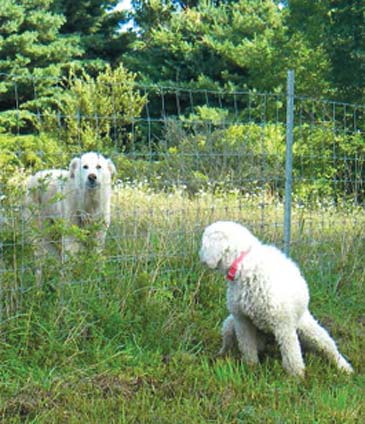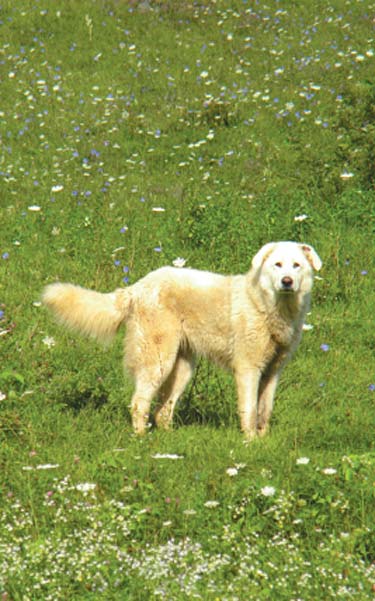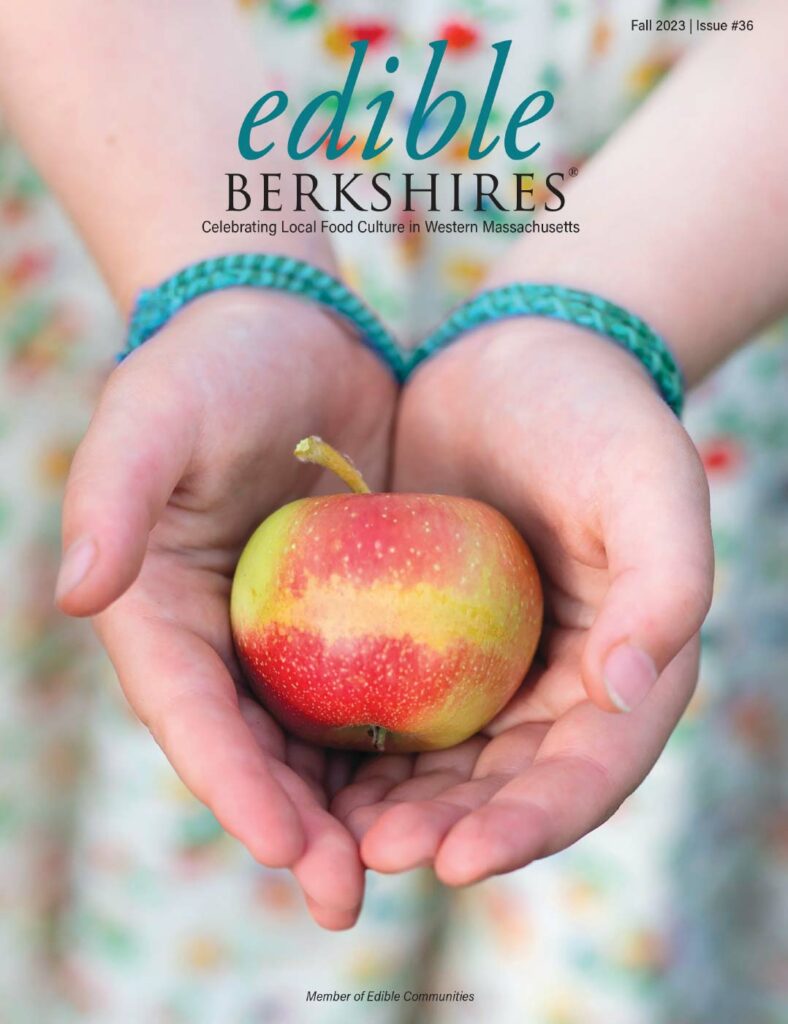The Maremmas of Stonehedge Farm
On a bright early summer morning at one of the lower barns of Lila Berle’s Stonehedge Farm in Great Barrington, the day was well under way. After a few weeks of nonstop haying in between the record rains of June, there was a little time for a break from chores.
Lila and her Standard Poodle, Butter, greeted a visitor in the barnyard while ducks, geese and ducklings, adopted by the geese when their mother was killed by a raven, ambled about. Butter bounded into the cab of a truck, where four large stainless-steel dishes containing kibble, some wet food and hard-cooked eggs (from Lila’s hens) were perched on the dash and seats.
“Let’s take a ride to meet the dogs.”
The dogs are Maremmas, an Italian breed of working sheep dogs thought to be 2,000 years old, which guard and live year-round with the sheep Lila has become so well known for. Her lamb is supplied to Dan Smith, a pioneer of Berkshires farm-to-table, at his restaurant John Andrews, and now also to Brian Alberg at the Red Lion Inn. For nearly 30 years she’s bred and raised her own breed of sheep, with flocks grazing on 400 acres, some of the most picturesque land in the Berkshires. But the land that offers panoramic views and sustains a working farm is also home to predators eager to feast on the flock, as well as the ducks, geese, hens and other farm dwellers. Mountain lions, bears, foxes and especially coyotes roam these hills.
That’s where the Maremmas come in. They were brought initially to the United States by behavioral scientists Ray and Lorna Coppinger through a grant at Hampshire College that began the Livestock Guarding Dog Project in 1976. For over a decade Hampshire biologists would place about 1,200 young guarding dogs with volunteer farmers and ranchers in 38 states. The project was undertaken as a long-term investigation into the behavior of a new kind of dog for farmers and ranchers in the U.S.
On the vast lands out west, significant re-education for ranchers was also involved—any dog in the middle of a herd was considered an aggressor and risked being shot. Along with the Hampshire College program, funding from the Rockefeller brothers also contributed to a program to replace the poisoning of undesired animals with the use of natural predators.
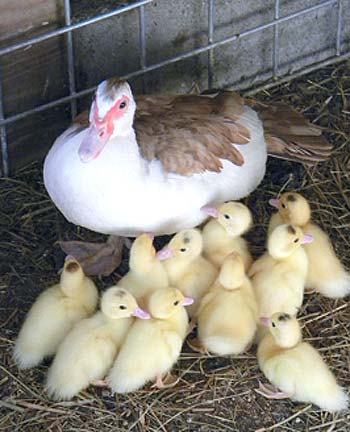
Duck mothering orphaned chicks.
The function of the Maremma is
dissuasion; their warning bark is
enough to keep predators at bay and
it is rare that they hunt down and kill
an interloper. Their floppy ears, Lila
points out, differ from German and
other shepherd dogs whose pointy,
upright ears indicate not only guard
dog protectiveness but also a greater
likelihood to go for the kill. The
Maremma will bark at approaching
coyotes, beginning a brief dialogue,
but by the second or third exchange
the coyotes will turn tail.
In southern Berkshire County, Lila received Maremmas, bred to guard sheep from wolves in Italy; other breeds, including Kuvasz from Hungary, Anatolian Shepherds from Turkey, and the Shar Planinetz from Yugoslavia, were also brought over.
The function of the Maremma is dissuasion; their warning bark is enough to keep predators at bay and it is rare that they hunt down and kill an interloper. Their floppy ears, Lila points out, differ from German and other shepherd dogs whose pointy, upright ears indicate not only guard dog protectiveness but also a greater likelihood to go for the kill. The Maremma will bark at approaching coyotes, beginning a brief dialogue, but by the second or third exchange the coyotes will turn tail.
The Maremmas guarding the Stonehedge flock now are Lady, with daughter Sophie and son Max, and recent addition Scilla. When we drove up to Sophie’s pasture, sheep placidly grazing, she was nowhere in sight but appeared within seconds when Lila called. Tall, a bit like a Great Pyrenees but less massive—though still a good 85 pounds— with long, rough off -white fur and pendant ears, she might have been any domestic canine waiting for her breakfast. There was no mistaking her for a house dog, though, given her no-nonsense warning bark at the unknown human approaching the gate. She was doing her job. These dogs are bred for a purpose and live year-round outside with the sheep. Though they accept Lila (and Butter, up to a point), other humans are really not of interest and are potentially a threat to their work. Lila has tried to educate neighbors about not stopping to talk to them should they pass by while out on a walk. These are true working dogs; interaction with humans is a distraction and if encouraged would begin to undermine their effectiveness. In the time they have been guarding, not a single sheep has been lost. At first hint of a threat, a particular bark from the dogs alerts the sheep to flock up. The predators are not only four-legged. Lila described a ewe caught in a fence a few weeks before whose eye was gouged out by a raven— the ewe is now one-eyed but back with the flock and doing fine.
Lila left Sophie her food—she actually just turns it out on the ground—and we were off to the next pasture to feed Lady, who is the fiercest and has killed a few coyotes; Max, largest of the four; and young but full grown Scilla. Lila waits longer after their feeding to be sure Lady eats her own, as she has a tendency to let Max take it.
As the sheep grazed around the truck and some hovered near the dogs’ food, what might have appeared a stray cow from Lila’s Scottish Highland long-haired cattle herd ambled up. “She thinks she’s a sheep,” Lila explained with a smile. Separated young from her mother, which couldn’t nurse her, she’d been bottle fed; she had spent her life to date with the flock and behaved like one of them, and the dogs herded her, as well.
There have been a number of Maremma through the years at Stonehedge, including a few litters born and living in silos, frolicking with the lambs as they grew. The positive relationship between Stonehedge and the Hampshire College project ensured a steady stream of individuals sent for training or just to try out on the farm. One dog named Blizzard stands out, though. Lila recounted how he arrived in the early years and his reputation grew to mythical status. Incredibly territorial, he once climbed in a neighbor’s car to guard spilled soup and stayed put to guard his treasure until forcibly removed. When the same neighbor’s dog went into heat, the only thing between the dog and all friendly males of the neighborhood was a dog door and Blizzard, who kept away all comers—but for his efforts finally ended up in the pound. His guarding prowess was matched only by his love of pickup trucks, which he would guard as well.
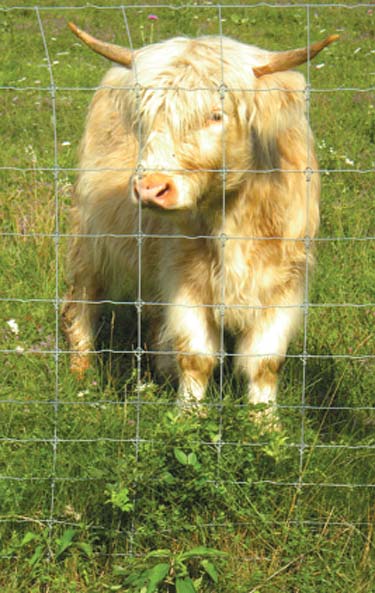
Scottish Highland long-haired cattle
Blizzard became well known enough for his feats that he was eventually called up to Cornell to help with a bear problem. They dug a bait pit, left Blizzard there to guard, and came back to find Blizzard, some clumps of bear fur, but no other remnants of the bear.
Back in the pasture, we sat in the truck observing the action for a while, the sheep gravitating to a higher meadow, some lingering with Lady, Max, Scilla and the cow in the shade of a copse of trees. Clouds scudded across the sky; the light was clear, with little humidity, and the lushness of vegetation from the high levels of recent rains made for an incredible array of greenness. Isn’t this awesome, Lila observed, and it would be impossible to disagree: The scene was utterly perfect in its beauty and the balance it showed between animals and land. There was simply a rightness about it.
A farm is a complex ecosystem of moving parts where ideally every piece works in tandem with the others and no effort goes wasted, down to the geese that eat the snails that host the parasites. Lila has bred her sheep—Rambouillets crossed with Romneys and Border Leicesters—to the land and climate of these Berkshire hillsides. They are sturdy, with stronger bones and feet, resistant to parasites, with better meat and wool and who don’t require grain. They rotate pastures about every three weeks, the lifecycle of parasites. The lamb goes to specialty butchers; the wool is made into blankets and yarn. The best, which are chosen by Lila and are bred, assure the continued high quality of the flock.
The Maremmas are a key part of this system, working to ensure the safety of the flock. The work is their reward, for they are doing what they have been bred for centuries to do. For a dog, this must be the ultimate reward.
Brigid Dorsey is a freelance writer and editor living in Columbia County. Along with teaching, consulting, corporate and not-for-profit stints, she briefly ran a (very) small food business. She holds a PhD in French from Princeton.



